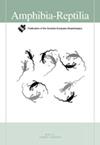Size-related changes and chemical basis of melanin-based body coloration in the amphisbaenian Trogonophis wiegmanni
IF 1.3
4区 生物学
Q3 ZOOLOGY
引用次数: 0
Abstract
Melanin is a fundamental pigment in animal coloration as it is involved in many different adaptive functions such as signaling or thermoregulation. Two forms of melanin are known to produce different colors (eumelanin: black; pheomelanin: yellow or brown). Here, we explored whether there were intersexual differences and/or size-related changes in melanization of the amphisbaenian Trogonophis wiegmanni, a fossorial species with a characteristic black and yellow color pattern of scales. We found a clear effect of body length, but not of sex, on the levels of melanization, which was also dependent on the body region; the proportion of melanin-dependent blackish coloration increased with body length in the dorsum, but decreased with body length in the ventral belly area. We also studied the chemical basis of this coloration using Raman spectroscopy and found that eumelanin was present in both black and yellow scales, but pheomelanin was not found in yellow scales, suggesting that this yellow coloration is caused by the reduction of eumelanin or dispersion of melanosomes and/or perhaps by other pigments.维格曼穴居双鱼体型变化及黑色素体色的化学基础
黑色素是动物着色的一种基本色素,它参与许多不同的适应功能,如信号传导或体温调节。已知有两种形式的黑色素会产生不同的颜色(真黑色素:黑色;黑素:黄色或棕色)。在此,我们探讨了两鱼种Trogonophis wiegmanni(一种具有典型黑黄鳞片图案的穴居物种)在黑化过程中是否存在性间差异和/或大小相关的变化。我们发现身体长度对黑化程度有明显的影响,而不是性别,黑化程度也取决于身体部位;在背部,黑色素依赖的黑色比例随体长而增加,而在腹侧区域,随体长而减少。我们还利用拉曼光谱研究了这种着色的化学基础,发现黑色和黄色鳞片中都存在真黑素,但黄色鳞片中没有发现泛黑素,这表明这种黄色着色是由真黑素减少或黑素体分散和/或其他色素引起的。
本文章由计算机程序翻译,如有差异,请以英文原文为准。
求助全文
约1分钟内获得全文
求助全文
来源期刊

Amphibia-Reptilia
生物-动物学
CiteScore
3.10
自引率
6.20%
发文量
39
审稿时长
6-12 weeks
期刊介绍:
Amphibia-Reptilia is a leading European multi-disciplinary journal devoted to most of the aspects of herpetology: ecology, behaviour, evolution, conservation, physiology, morphology, paleontology, genetics, and systematics.
Amphibia-Reptilia publishes high quality original papers, short-notes, reviews, book reviews and news of the Societas Europaea Herpetologica (SEH). The Societas Europaea Herpteologica (SEH) website is located at: www.seh-herpetology.org.
 求助内容:
求助内容: 应助结果提醒方式:
应助结果提醒方式:


